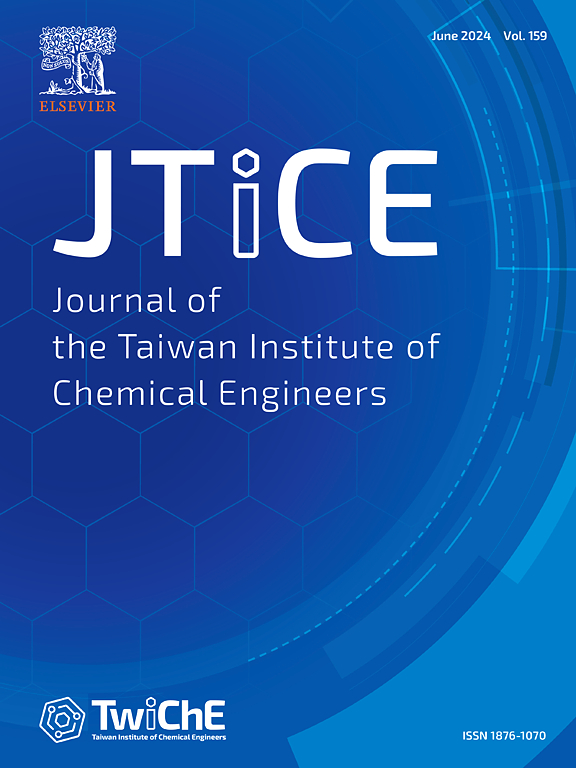High-performance electrochemical sensors with SnBi2O3/Graphene oxide nanocomposite for selective antibiotic detection
IF 5.5
3区 工程技术
Q1 ENGINEERING, CHEMICAL
Journal of the Taiwan Institute of Chemical Engineers
Pub Date : 2025-03-09
DOI:10.1016/j.jtice.2025.106033
引用次数: 0
Abstract
Background
Environmental contaminants like nitrofurans (NF) can be detected using rapid, sensitive, and efficient monitoring techniques. However, ineffective detection systems delay responses, allowing contaminants to persist in the environment, increasing their toxicity, and causing long-term harm to ecosystems and human health. An alternative is the electrochemical method for NF detection, which is fast, cost-effective, and reliable.
Methods
We developed a low-cost, portable nanocomposite material, Sn-Bi₂O₃/GO, for the detection of NF, marking its first reported use. The crystallinity, functional groups, surface structure, and oxidation states of the materials were analyzed through various analytical and spectroscopic techniques.
Significant findings
SnBi₂O₃/GO composites modified glassy carbon electrode (GCE) surface was employed to detect NF using cyclic voltammetry (CV) and differential pulse voltammetry (DPV). Then, the SnBi₂O₃/GO/GCE showed outstanding selectivity, even in the presence of interfering substances, with a wide linear detection range from 0.023 µM to 814.36 µM, a detection limit (LOD) of 0.0124 µM (S/N = 3), and an ultra-sensitivity of 2.857 μA μM−1 cm−2. Additionally, the SnBi₂O₃/GO/GCE successfully detected NF in biofluids and water samples, demonstrating satisfactory accuracy and recovery.

用于选择性抗生素检测的SnBi2O3/氧化石墨烯纳米复合材料的高性能电化学传感器
背景:硝基呋喃(NF)等环境污染物可以使用快速、灵敏和高效的监测技术进行检测。然而,无效的检测系统会延迟反应,使污染物在环境中持续存在,增加其毒性,并对生态系统和人类健康造成长期危害。另一种方法是电化学法检测NF,该方法快速、经济、可靠。方法我们开发了一种低成本、便携式的纳米复合材料Sn-Bi₂O₃/GO,用于NF的检测,这是其首次被报道使用。通过各种分析和光谱技术分析了材料的结晶度、官能团、表面结构和氧化态。利用snbi₂O₃/GO复合材料修饰的玻碳电极(GCE)表面,采用循环伏安法(CV)和差分脉冲伏安法(DPV)检测NF。结果表明,SnBi₂O₃/GO/GCE具有良好的选择性,即使存在干扰物质,其线性检测范围为0.023µM ~ 814.36µM,检出限(LOD)为0.0124µM (S/N = 3),超灵敏度为2.857 μA μM−1 cm−2。此外,SnBi₂O₃/GO/GCE成功地检测了生物流体和水样中的NF,表现出令人满意的准确性和回收率。
本文章由计算机程序翻译,如有差异,请以英文原文为准。
求助全文
约1分钟内获得全文
求助全文
来源期刊
CiteScore
9.10
自引率
14.00%
发文量
362
审稿时长
35 days
期刊介绍:
Journal of the Taiwan Institute of Chemical Engineers (formerly known as Journal of the Chinese Institute of Chemical Engineers) publishes original works, from fundamental principles to practical applications, in the broad field of chemical engineering with special focus on three aspects: Chemical and Biomolecular Science and Technology, Energy and Environmental Science and Technology, and Materials Science and Technology. Authors should choose for their manuscript an appropriate aspect section and a few related classifications when submitting to the journal online.

 求助内容:
求助内容: 应助结果提醒方式:
应助结果提醒方式:


